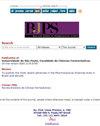Biological screening of herbal extracts and essential oil from Plectranthus species: α-amylase and 5-lipoxygenase inhibition and antioxidant and anti-Candida potentials
IF 0.9
4区 医学
Q4 PHARMACOLOGY & PHARMACY
引用次数: 0
Abstract
The phenolic compound content, the antioxidant and α-amylase inhibition potentials of different extracts of the Plectranthus amboinicus , P. barbatus and P. ornatus were evaluated. We also evaluated the influence of plant growth and harvest time on the chemical composition of the essential oil (EO) of P. amboinicus , its antioxidant and anti-Candida activities and the α-amylase and lipoxygenase inhibitions. The turbo-extract of P. barbatus showed the greatest phenolic compound content and antioxidant activity. No α-amylase inhibition activity was observed in the analyzed extracts, but the turbo-extraction and refluxing extracts possessed high antioxidant activities. Protected cultivation and morning harvest conditions gave the best antioxidant activities, which was associated to the highest carvacrol content. P. amboinicu s EO antioxidant activity could contribute to the reduction of oxidative stress in diabetes. Causal Candida strains of diabetic foot ulcers showed sensitivity to P. amboinicus EO. C. albicans and C. dubliniensis were the most sensitive of the selected Candida strains. Turbo-extracts or refluxing of the three species extracts and the EO of P. amboinicus should be considered as a potential candidate for the management the complications of type 2 diabetes.植物提取物和精油的生物学筛选:α-淀粉酶和5-脂氧合酶抑制及抗氧化和抗念珠菌潜能
对三种不同提取物的酚类化合物含量、抗氧化活性和α-淀粉酶抑制活性进行了比较。我们还评估了植物生长和采收时间对P. amboinicus挥发油(EO)化学成分、抗氧化和抗念珠菌活性以及α-淀粉酶和脂氧合酶抑制作用的影响。巴贝藤涡轮提取物的酚类化合物含量和抗氧化活性最高。对α-淀粉酶无抑制作用,但涡轮提取和回流提取具有较高的抗氧化活性。保护性栽培和晨采条件下,其抗氧化活性最好,且与香芹酚含量最高有关。P. amboinicu的EO抗氧化活性可能有助于降低糖尿病的氧化应激。糖尿病足溃疡的假丝酵母菌菌株对amboinicus EO敏感。白色念珠菌和都柏林念珠菌对所选念珠菌最敏感。这三种提取物的涡轮提取物或回流和P. amboinicus的EO应被认为是治疗2型糖尿病并发症的潜在候选药物。
本文章由计算机程序翻译,如有差异,请以英文原文为准。
求助全文
约1分钟内获得全文
求助全文
来源期刊

Brazilian Journal of Pharmaceutical Sciences
PHARMACOLOGY & PHARMACY-
CiteScore
1.40
自引率
0.00%
发文量
165
审稿时长
7.5 months
期刊介绍:
The Brazilian Journal of Pharmaceutical Sciences accepts for publication Original Papers applicable to the fields of Pharmaceutical Sciences; Reviews and Current Comment Articles, which are published under the Scientific Editor and Associate Editors invitation to recognized experts or when they are spontaneously submitted by the authors in the form of abstracts to have their importance evaluated. A critical view of the subject with insertions of results of previous works in the field in relation to the state of art must be included; Short Communications reporting new methods and previews of works on researches of outstanding importance in which originality justify a quick publication. A maximum of 2000 words excluding tables, figures and references is an acceptable limit. One table, one figure and ten references may be added, and Book Reviews of the latest editions of books, prepared by specialists invited by the Scientific Editor and Associate Editors. Thematic Supplements as well as those related to scientific meetings can be published under the Scientific Editor and/or Associate Editors agreement.
 求助内容:
求助内容: 应助结果提醒方式:
应助结果提醒方式:


